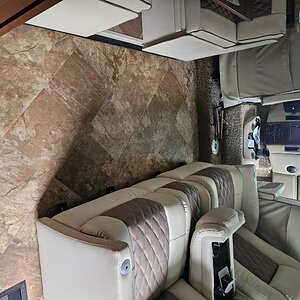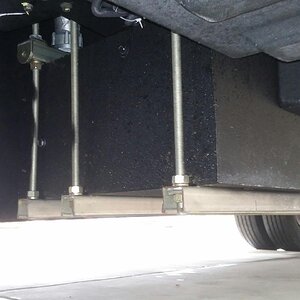turbopilot
RVF Supporter
- Joined
- Nov 2, 2019
- Messages
- 725
- Location
- Prescott, AZ
- RV Year
- 2026
- RV Make
- LightShip
- RV Model
- AE.1 Cosmos
- RV Length
- 26
- Engine
- Electric
- TOW/TOAD
- 2025 Ford F-150 PowerBoost HEV
- Fulltimer
- No
I asked Grok to summarize the history of RV design and the Form Follows Function design principle. Turns out there was any amazing similarity to this revolution in towable RV's dating back almost 100 years. Is the LightShip ugly? It may be to some people, but for others who subscribe to the Form Follows Function design principle, it is a work of art.
Even more interesting both the Airstream and the Bouless are still being sold today.
Groks take:
Form Follows Function: The Design Principle
"Form follows function" is a foundational principle in architecture and design, coined by American architect Louis Sullivan in 1896. It posits that the shape or appearance (form) of an object, building, or product should primarily be determined by its intended purpose or function, rather than aesthetic considerations alone. Sullivan famously applied this to skyscrapers, arguing that their tall, vertical forms naturally arose from the need for efficient office space in urban environments. This idea became a rallying cry for modernist designers in the early 20th century, emphasizing practicality, efficiency, and the elimination of unnecessary ornamentation. However, the principle itself has been subject to debate and controversy, with critics arguing it can lead to overly austere or impersonal designs, and its authorship has been variably attributed over time. By the 1930s, it influenced the Streamline Moderne style, which applied aerodynamic forms to everyday objects like vehicles and appliances to symbolize speed, modernity, and efficiency amid the Great Depression.
The Airstream Trailers and Their Embodiment of "Form Follows Function" in the 1930s
Airstream trailers, founded by Wally Byam in 1931 (with production ramping up in the mid-1930s), are a classic example of "form follows function" in industrial design. Inspired by aviation, these aluminum travel trailers were engineered for aerodynamic efficiency: their rounded, streamlined shape reduced wind resistance (like a "stream of air," hence the name), making them lighter and easier to tow with standard cars of the era. The use of riveted aluminum—borrowed from aircraft construction—kept weight low (around 1,100–2,000 pounds for early models) while providing durability and corrosion resistance, prioritizing functionality for long-distance travel over decorative elements. The iconic 1936 Airstream Clipper model, in particular, exemplified this: its semi-monocoque structure (a shell supported by internal framing) optimized interior space, fuel efficiency, and stability on the road, aligning with modernist ideals of form dictated by practical needs like mobility during economic hardship.
The Controversy Surrounding Airstream in the 1930s: Design Origins and Allegations of Copying
The primary controversy tied to Airstream in the 1930s revolves around its design origins and accusations that Wally Byam copied elements from Hawley Bowlus's earlier Bowlus Road Chief trailer. Bowlus, an aircraft engineer who oversaw the construction of Charles Lindbergh's Spirit of St. Louis airplane, introduced the Road Chief in 1934 as the first riveted aluminum travel trailer. It featured a full monocoque construction (a self-supporting shell) with an aerodynamic, bullet-like shape and a rear door over the tongue, emphasizing function through lightweight materials and wind-cheating form for easy towing.
Byam, who had been involved in selling Bowlus trailers as a salesperson, launched the Airstream Clipper in 1936 after Bowlus-Teller Manufacturing Co. faced financial difficulties due to the Great Depression and went into liquidation in 1936–1937. Byam purchased Bowlus's manufacturing equipment and materials at a bankruptcy auction, then produced the Clipper, which shared the signature rounded aluminum shape but included modifications like relocating the door to the side for better accessibility, adding more interior cabinets, and using a semi-monocoque build for customization. While Byam legally acquired the assets and made improvements, many accounts describe the Clipper as a direct copy of the Road Chief's core design, sparking ongoing debate in collector and enthusiast circles. One unconfirmed anecdote suggests Byam approached Bowlus about using the design, to which Bowlus replied he "couldn't stop him." No formal lawsuits or direct disputes between Byam and Bowlus are documented—Bowlus returned to aviation after the bankruptcy—but the perception of imitation persists, especially among modern Bowlus revivalists who position their trailers as the "original" uncopied design. This narrative has fueled discussions about intellectual property in early industrial design, particularly since only about 80 Road Chiefs were produced before the company's collapse, while Airstream thrived by building to order and adapting to market demands.
Additionally, broader contextual controversy surrounded these trailers in the 1930s: their high prices (around $1,200–$1,500 during the Depression, equivalent to a year's salary for many) made them luxury items amid widespread poverty, drawing criticism for being out of reach for average families despite their functional innovations. Bowlus's failure was partly attributed to overproduction without demand, while Airstream's success highlighted adaptable business practices.
| Aspect | Bowlus Road Chief (1934) | Airstream Clipper (1936) |
|---|---|---|
| Designer/Founder | Hawley Bowlus | Wally Byam |
| Key Functional Features | Aerodynamic aluminum monocoque shell; lightweight (1,100 lbs); rear door over tongue for structural integrity | Similar aerodynamic aluminum shape; semi-monocoque; side door for usability; customizable interiors |
| Production Fate | ~80 units; bankrupt in 1936–1937 due to Depression and overproduction | Successful; built to order, leading to long-term brand viability |
| Controversy Element | Original design; no direct dispute but seen as source for copies | Accused of copying shape; Byam bought assets legally but modified minimally at first |
In summary, Airstream's 1930s designs vividly illustrated "form follows function" through aviation-inspired efficiency, but the brand's origins are shadowed by allegations of design appropriation from Bowlus, reflecting tensions in the emerging RV industry during economic turmoil.












